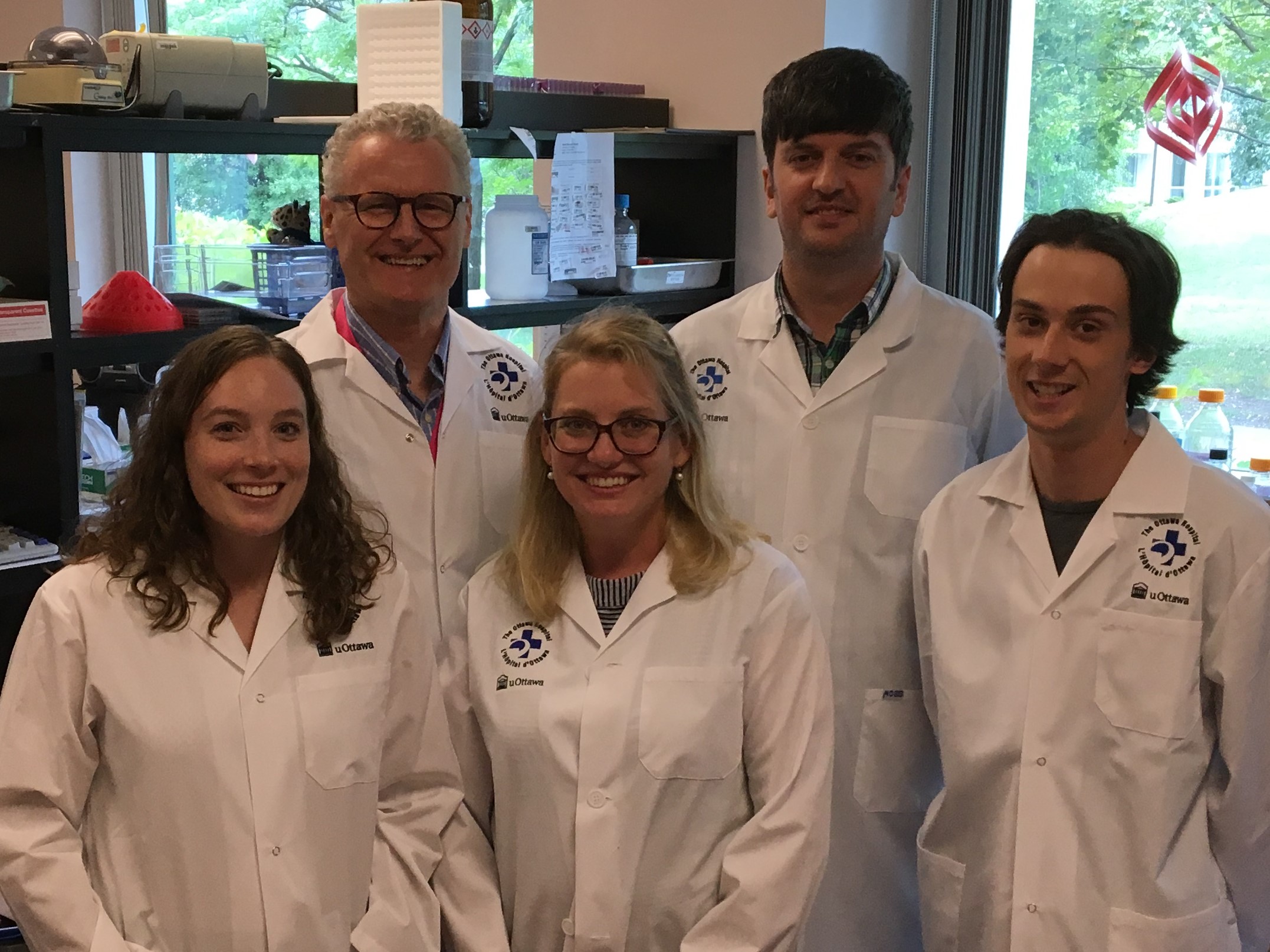Unravelling the mystery of how one gene contributes to Parkinson’s, Crohn’s and leprosy
 Increased inflammation may explain the link between Parkinson's, Crohn's and leprosy, according to new research from five Canadian institutions. Team members from the Schlossmacher lab include (clockwise from top left) Dr. Michael Schlossmacher, Dr. Bojan Shutinoski, Quinton Hake-Volling, Dr. Julianna Tomlinson and Nathalie Lengacher. Researchers have struggled for years to understand how mutations in one gene, called LRRK2, can increase the risk of three very different diseases: Parkinson's (a brain disease), Crohn's (a gut disease) and leprosy (a peripheral nervous system disease). Now, a Canadian team has found that inflammation is the likely culprit. Their results are published in Science Translational Medicine.
Increased inflammation may explain the link between Parkinson's, Crohn's and leprosy, according to new research from five Canadian institutions. Team members from the Schlossmacher lab include (clockwise from top left) Dr. Michael Schlossmacher, Dr. Bojan Shutinoski, Quinton Hake-Volling, Dr. Julianna Tomlinson and Nathalie Lengacher. Researchers have struggled for years to understand how mutations in one gene, called LRRK2, can increase the risk of three very different diseases: Parkinson's (a brain disease), Crohn's (a gut disease) and leprosy (a peripheral nervous system disease). Now, a Canadian team has found that inflammation is the likely culprit. Their results are published in Science Translational Medicine.
Inflammation, which is associated with swelling, redness, heat and pain, is the body's first defense against viruses, bacteria and injuries. But when inflammation is too strong or lasts too long, it can cause collateral damage to the body.
"Everyone thought that LRRK2's primary role was in the brain, because of its association with Parkinson's disease. But our research shows for the first time that its primary role is probably in the immune system," said senior author Dr. Michael Schlossmacher, Bhargava Family Research Chair in Neurodegeneration, Director of Neuroscience and a neurologist at The Ottawa Hospital, and professor at the University of Ottawa Brain and Mind Research Institute.
"Our research suggests that certain mutations in LRRK2 enhance inflammation and help the body to defend itself better against viruses and bacteria, but this enhanced inflammation could also increase the risk of Parkinson's and other brain diseases," added Dr. Schlossmacher.
LRRK2 protects against infections
LRRK2 is mutated in about two percent of people with Parkinson's disease, making it the second most common Parkinson's-associated gene. The researchers studied a particular mutation called LRRK2 p.G2019S, which increases the activity of the LRRK2 protein. They found that mice with this mutation had a stronger inflammatory response to both bacteria (Salmonella) and viruses (reovirus). Intriguingly, they found that this inflammatory response could spill over into the brain, even when the infection itself never reached the brain. The researchers looked at several markers of inflammation, including oxidative stress.
"When mice with the Parkinson's-linked mutation were infected with Salmonella bacteria, we saw very high levels of oxidative stress in the brain, almost twice as high as in normal mice," said first author Dr. Bojan Shutinoski, a research associate at The Ottawa Hospital. "This was particularly surprising because the bacteria never even entered their nervous system!"
The researchers also found that mice with the Parkinson's linked LRRK2 mutation were better at fighting off infections that normal mice, while mice without any LRRK2 were worse.
Interestingly, the researchers also observed that LRRK2 had a stronger inflammatory effect in female mice than in male mice, which reflects clinical data on patients with LRRK2 mutations.
Research supports theory that Parkinson's could start outside brain
This new research supports a theory, first proposed by German researchers in 2003, which suggests that Parkinson's may start outside the brain, in organs like the nose and the gut, which are on the front line of invasion by microbes and thus, sites of inflammation.
"If this theory about LRRK2 is correct, it could open the door for the monitoring of infections as a key risk element for prediction, early detection and prevention of Parkinson's, and importantly, for new treatment approaches in general," said Dr. Schlossmacher.
This concept is also supported by population health studies that show links between Parkinson's disease and inflammatory conditions in other organs. For example, people with Crohn's, an inflammatory gut disease also have a higher chance of developing Parkinson's, but when treated with a potent anti-inflammatory drug, this elevated risk disappears.
"This theory hasn't been proven yet, but I think we are now seeing some very compelling evidence from both laboratory research and human studies," said co-author Dr. Earl Brown, a professor emeritus and virus expert at the University of Ottawa, who has worked with the team since 2013.
Implications for clinical trials
The research also has implications for ongoing clinical trials of Parkinson's drugs that block LRRK2 activity.
"Our research suggests that these drugs may well succeed in safely reducing excessive inflammation", said Dr. Shutinoski. "However, we should be careful not to abolish LRRK2 function altogether, as this could make people more susceptible to infections, in particular when being treated potentially for years."
Link with leprosy
LRRK2 mutations are also associated with leprosy, a chronic infectious disease characterized by lesions in the nerve endings of the skin. The link to LRRK2 is thought to be caused by excessive inflammation in response to a type of mycobacterium, which infects peripheral nerves.
"This research, which shows that LRRK2 enhances inflammation, fits well with the view that it is the body's inflammatory response that is the most damaging part of leprosy pathogenesis" said Dr. Erwin Schurr, senior scientist at the Research Institute of the McGill University Health Centre (RI-MUHC) and member of the research team.
Team approach key
"What is remarkable for us is that these discoveries have been made possible by a very open collaboration among seven research teams at five Canadian institutions," said Dr. Schlossmacher. "We are very grateful to all our collaborators and funders."
Principal Investigators of the CLINT (Canadian LRRK2 in INflammation Team) include: Drs. M. Schlossmacher (The Ottawa Hospital, University of Ottawa), D. Park (formerly the University of Ottawa and now at the Hotchkiss Brain Institute), D. Gibbings (University of Ottawa), S. Hayley (Carleton University), D. Philpott (University of Toronto), J.D. Rioux (University of Montreal) and E. Schurr (McGill University). Dr. E. Brown (University of Ottawa) is also part of the team.
CLINT was funded through a team grant from the Canadian Institutes of Health Research from 2014 to 2019. The new research result was also funded by the Parkinson Research Consortium of Ottawa, the Canada Research Chair Program, NSERC, the Michael J. Fox Foundation for Parkinson's Research, The Ottawa Hospital Foundation, the Uttra and Sam Bhargava Family, the Department of Medicine at The Ottawa Hospital and the University of Ottawa Brain and Mind Research Institute.
The Ottawa Hospital: Inspired by research. Driven by compassion
The Ottawa Hospital is one of Canada's largest learning and research hospitals with over 1,100 beds, approximately 12,000 staff and an annual budget of over $1.2 billion. Our focus on research and learning helps us develop new and innovative ways to treat patients and improve care. As a multi-campus hospital, affiliated with the University of Ottawa, we deliver specialized care to the Eastern Ontario region, but our techniques and research discoveries are adopted around the world. We engage the community at all levels to support our vision for better patient care. See www.ohri.ca for more information about research at The Ottawa Hospital.
University of Ottawa: A crossroads of cultures and ideas
The University of Ottawa is home to over 50,000 students, faculty and staff, who live, work and study in both French and English. Our campus is a crossroads of cultures and ideas, where bold minds come together to inspire game-changing ideas. We are one of Canada's top 10 research universities--our professors and researchers explore new approaches to today's challenges. One of a handful of Canadian universities ranked among the top 200 in the world, we attract exceptional thinkers and welcome diverse perspectives from across the globe. www.uottawa.ca
Media contact
Jenn Ganton, Ottawa Hospital Research Institute, Cell: 613-614-5253, jganton@ohri.ca
Learn more about:
The Ottawa Hospital is a leading academic health, research and learning hospital proudly affiliated with the University of Ottawa and supported by The Ottawa Hospital Foundation.


